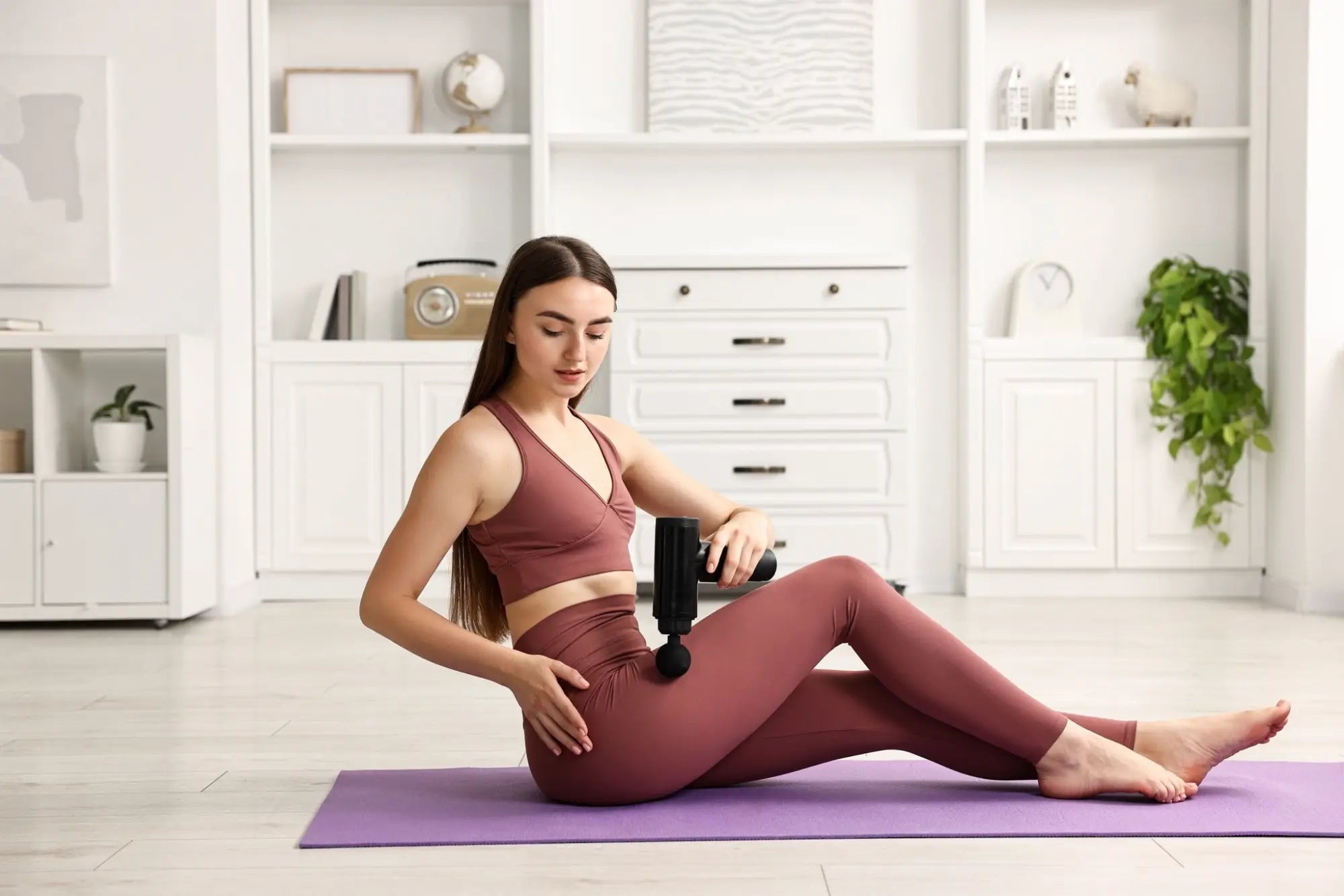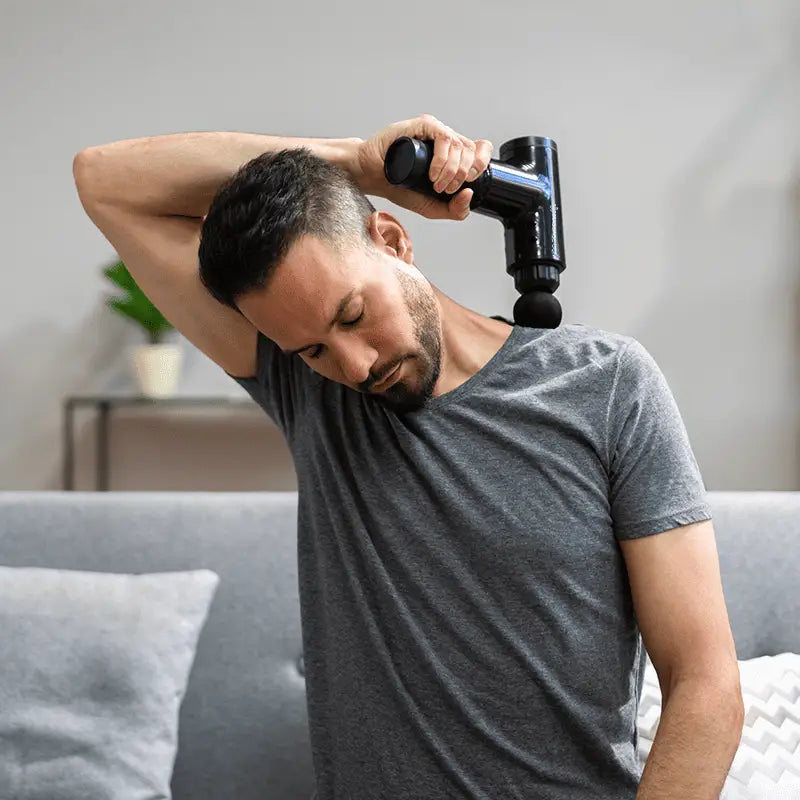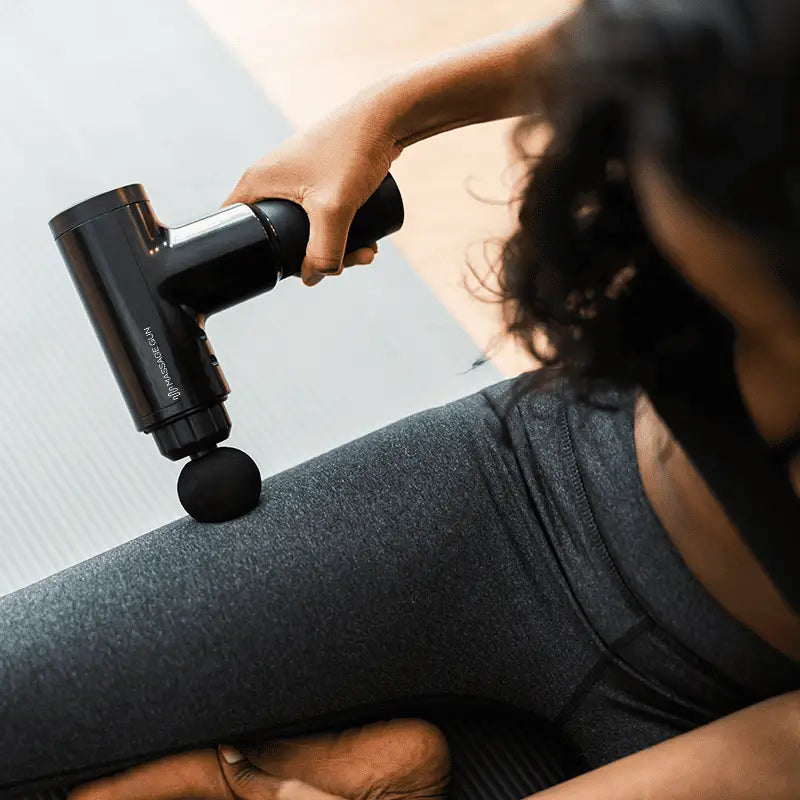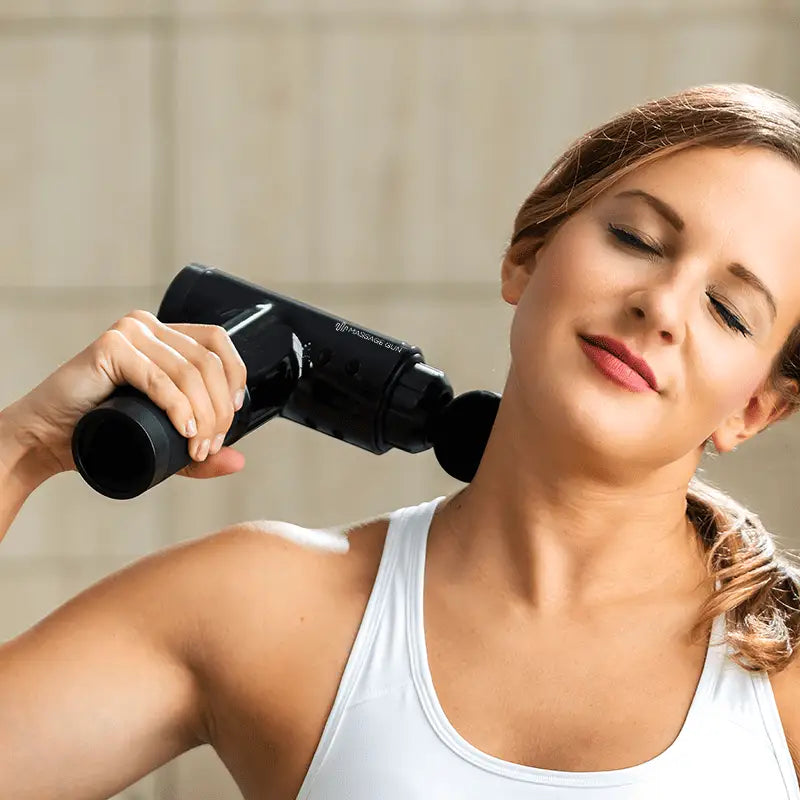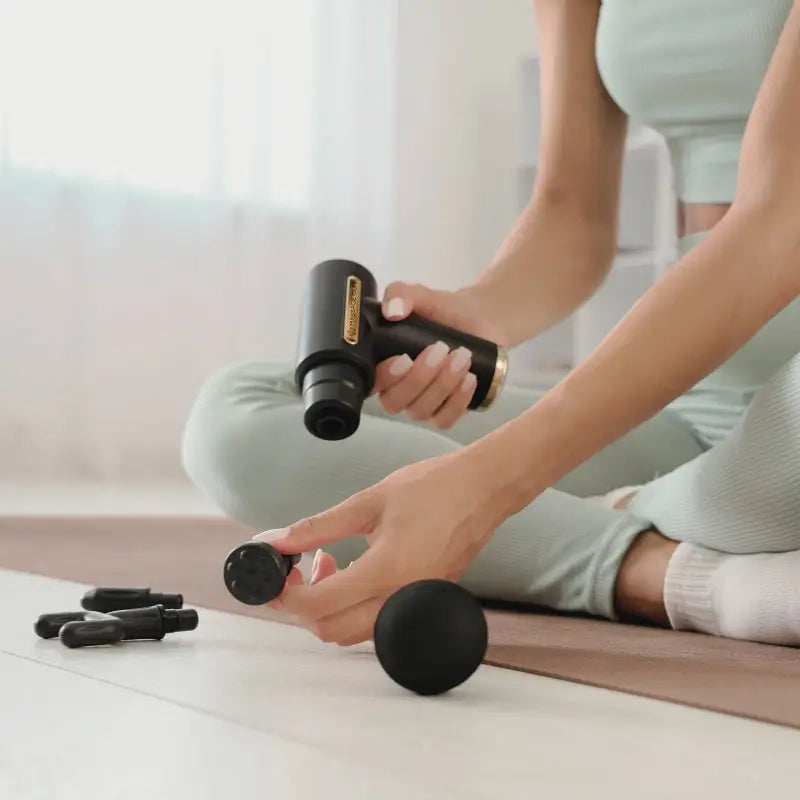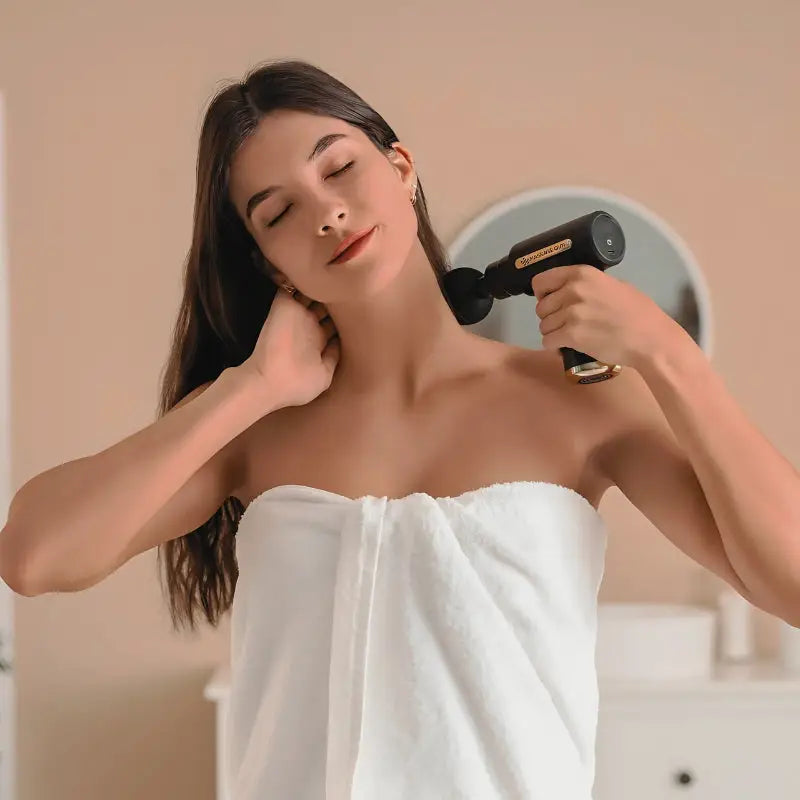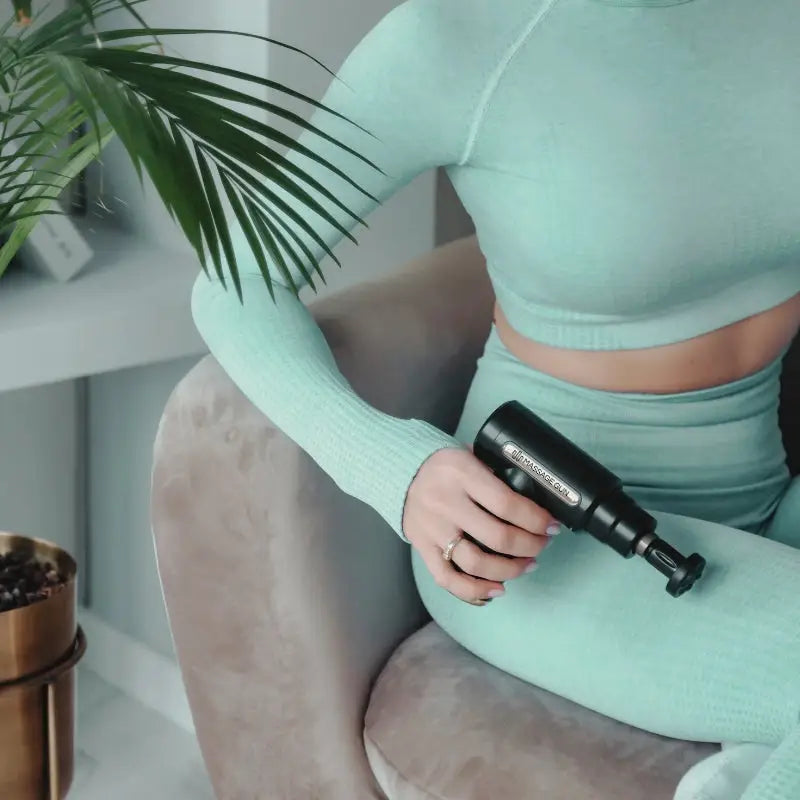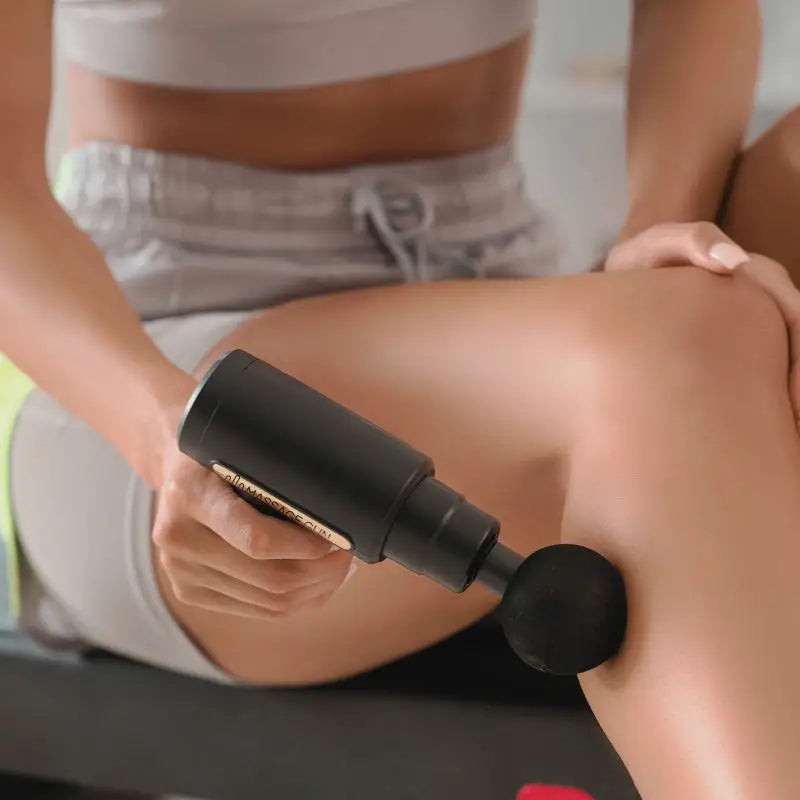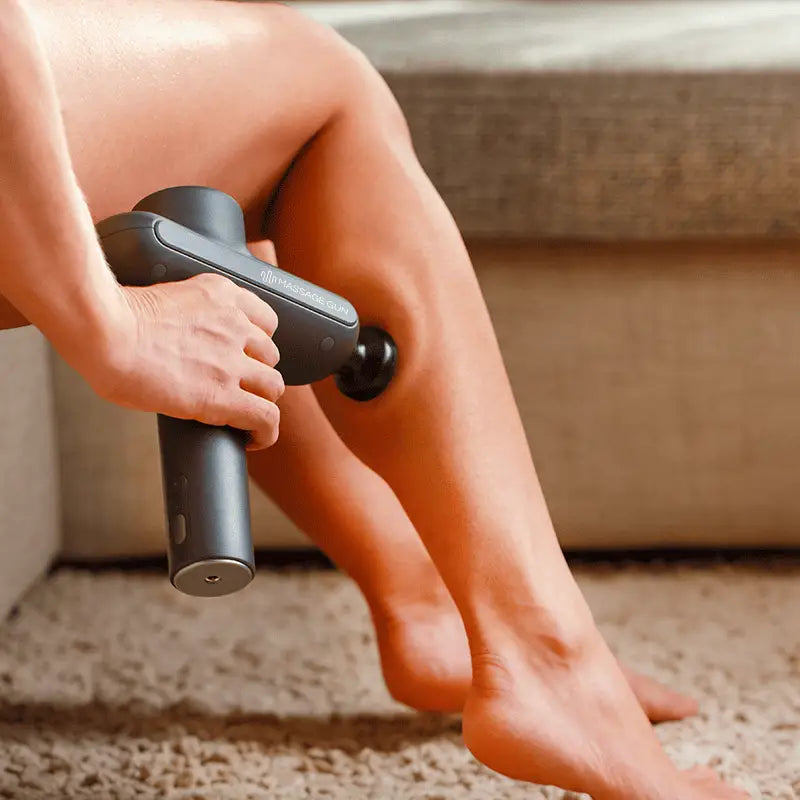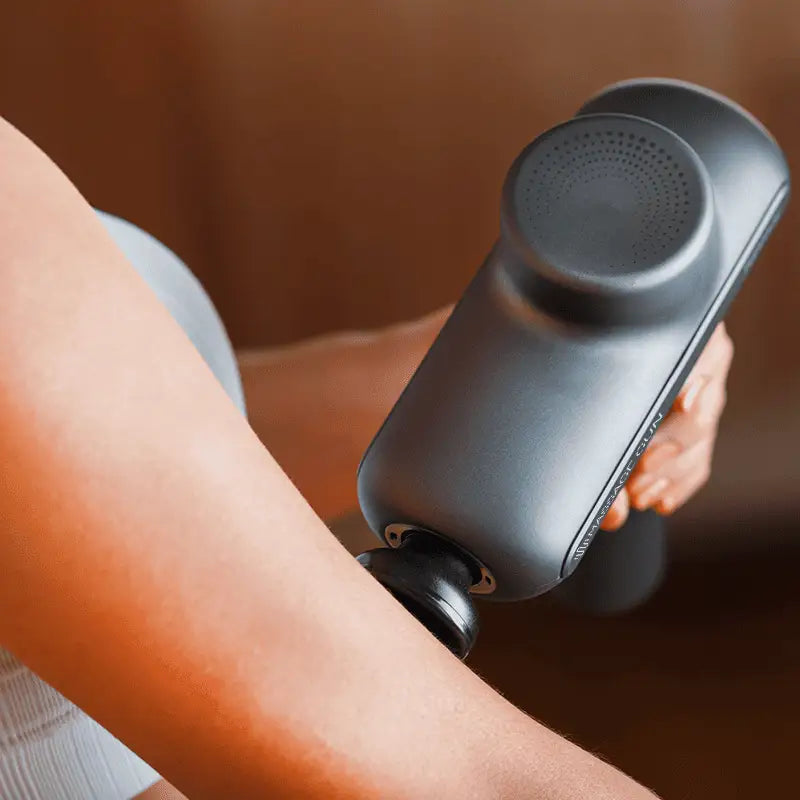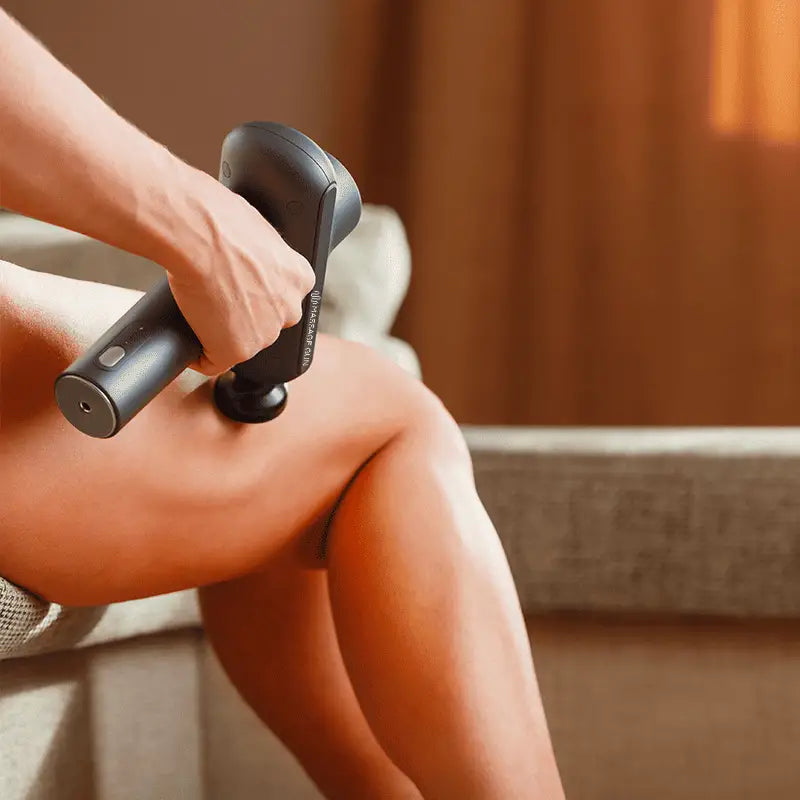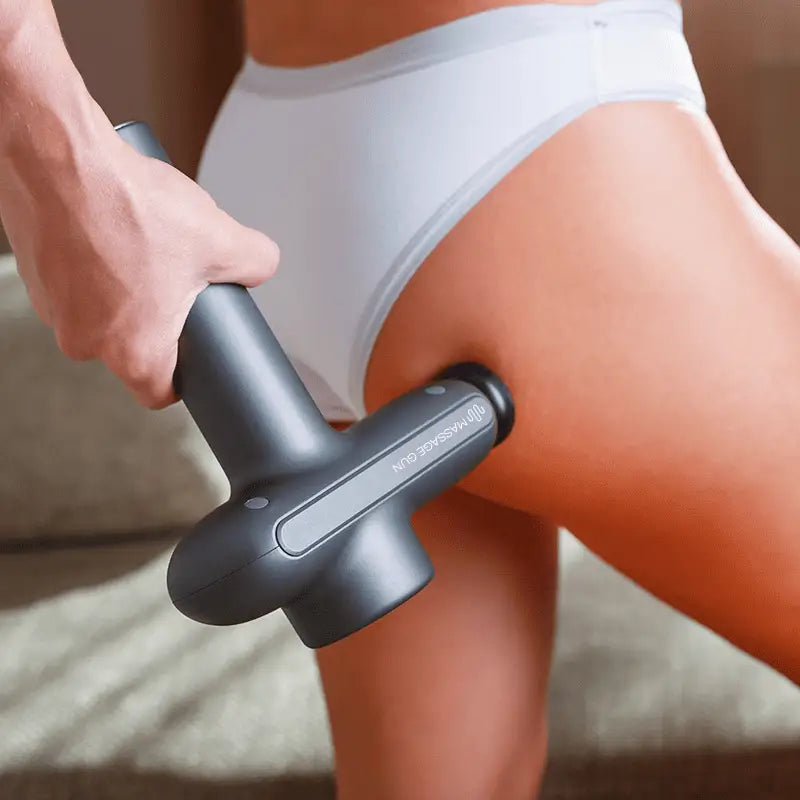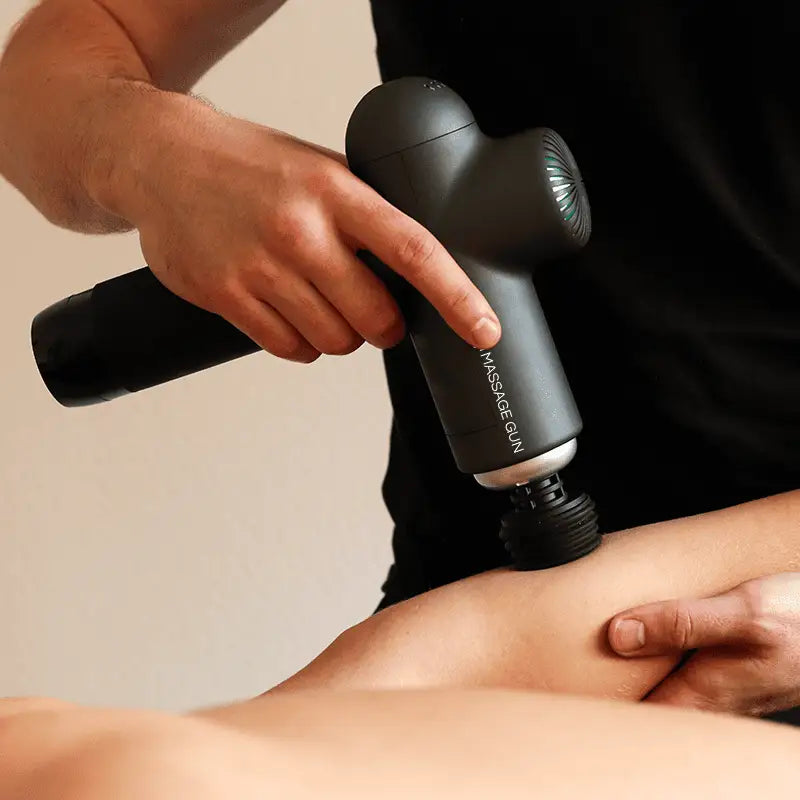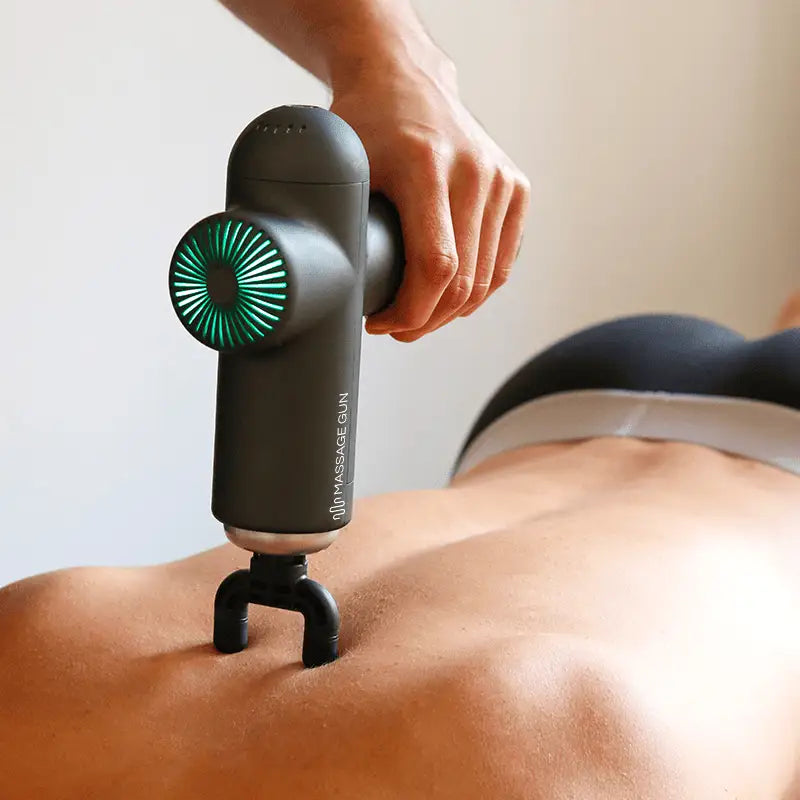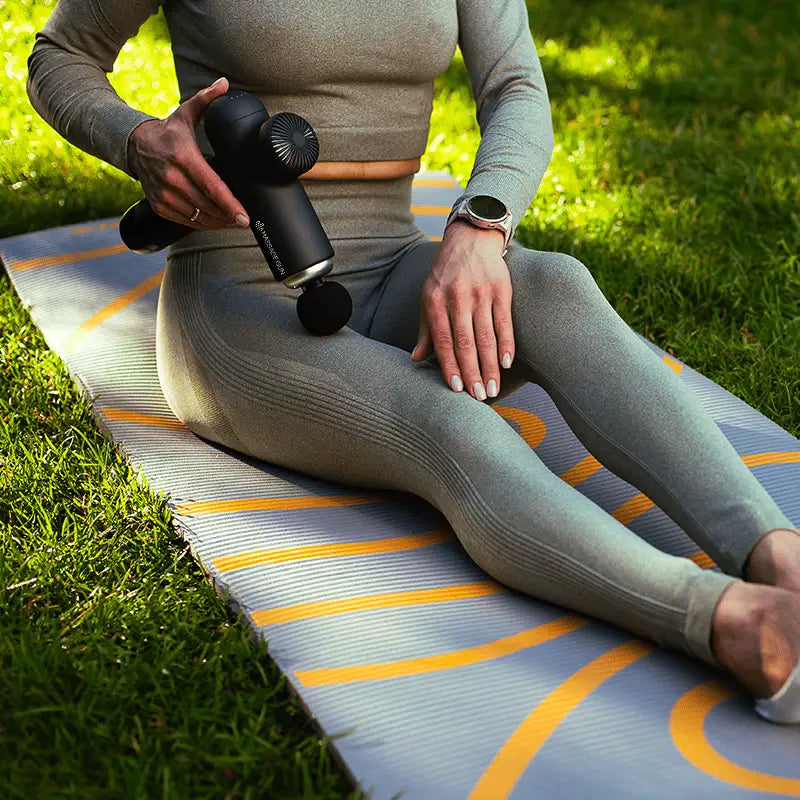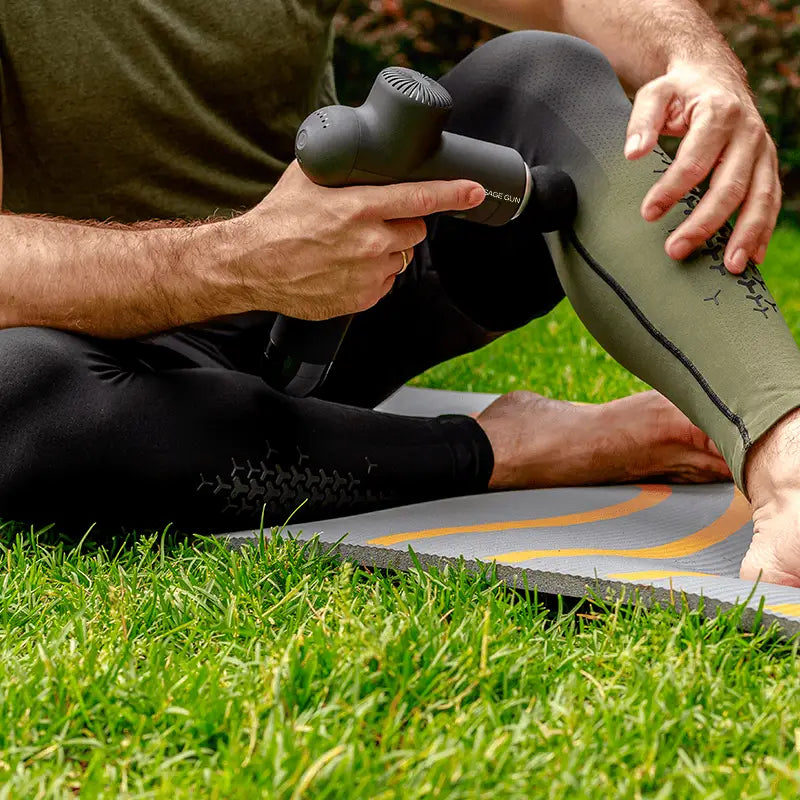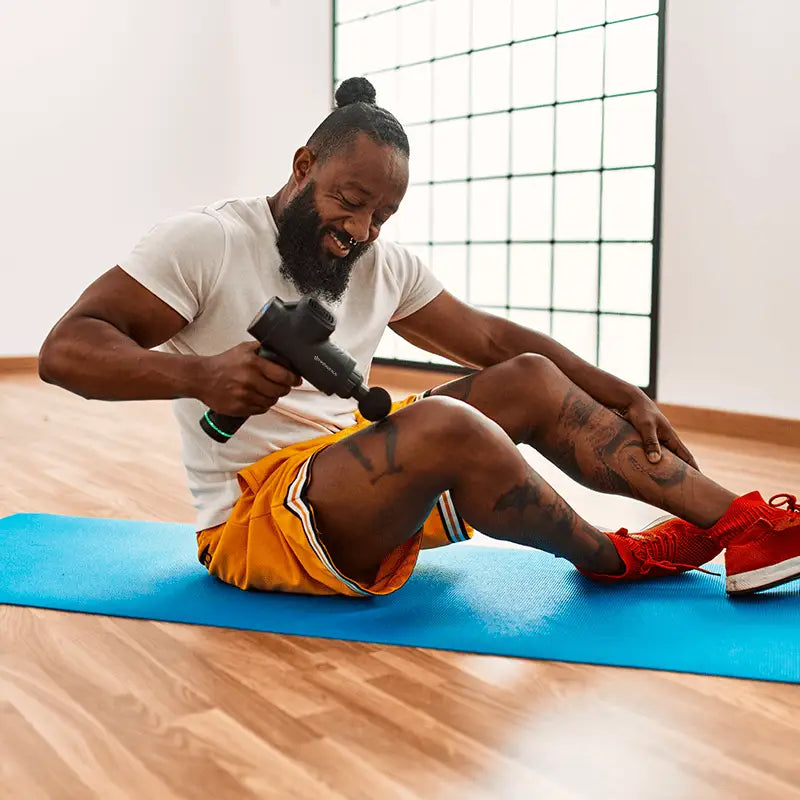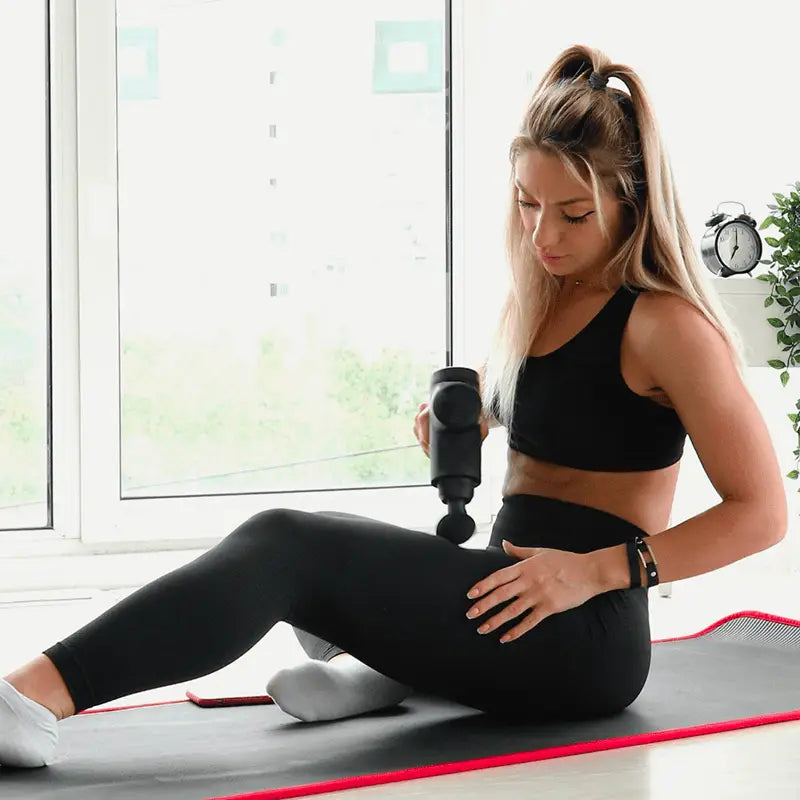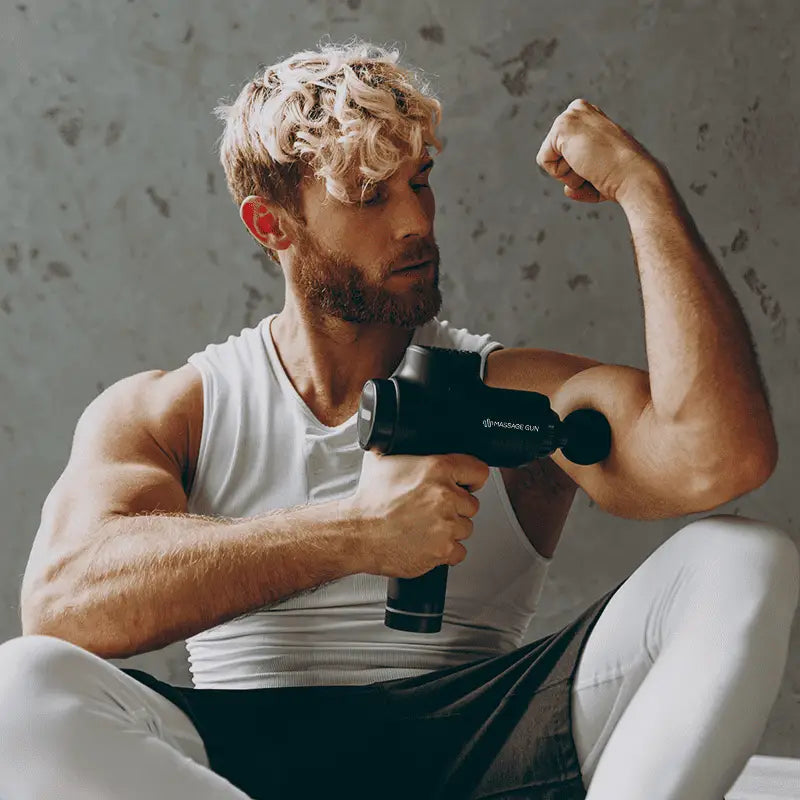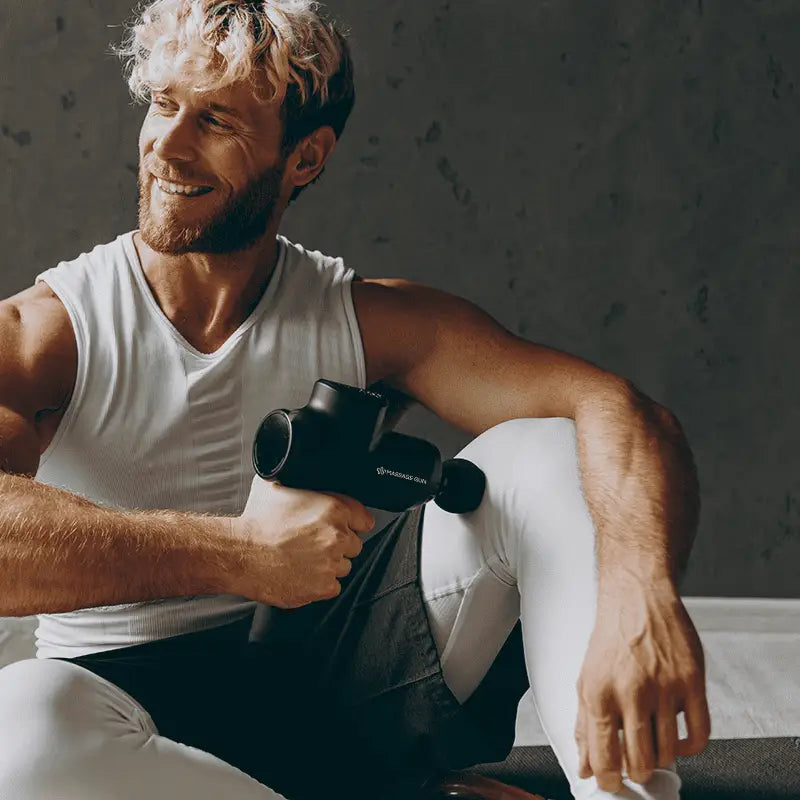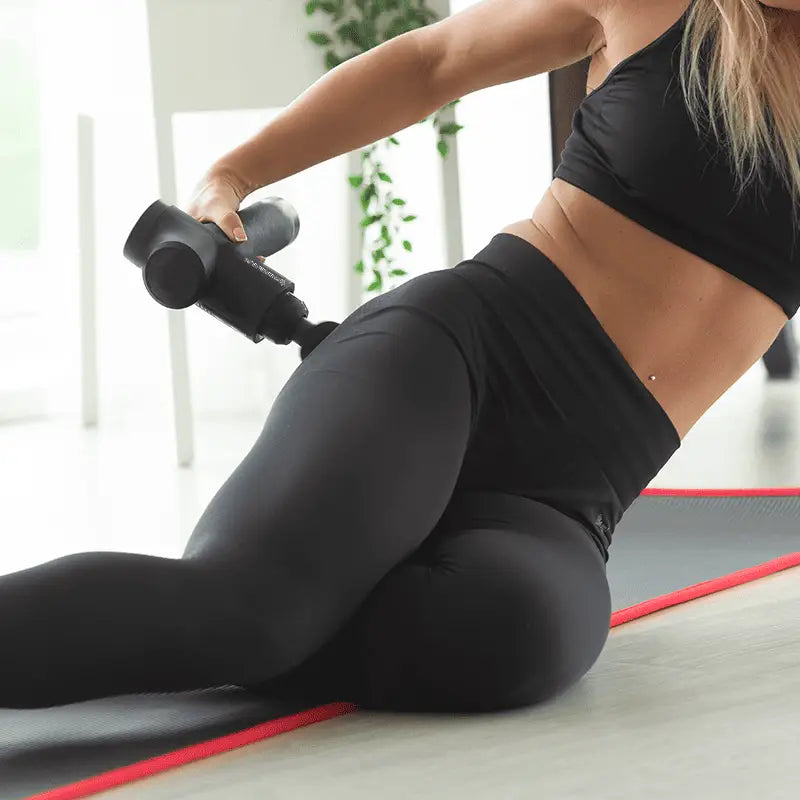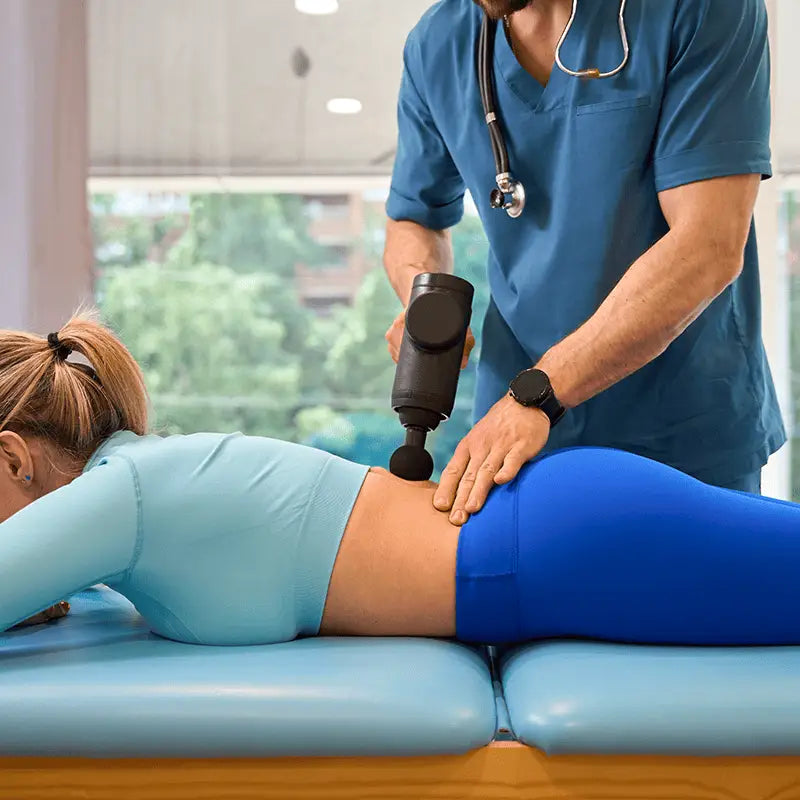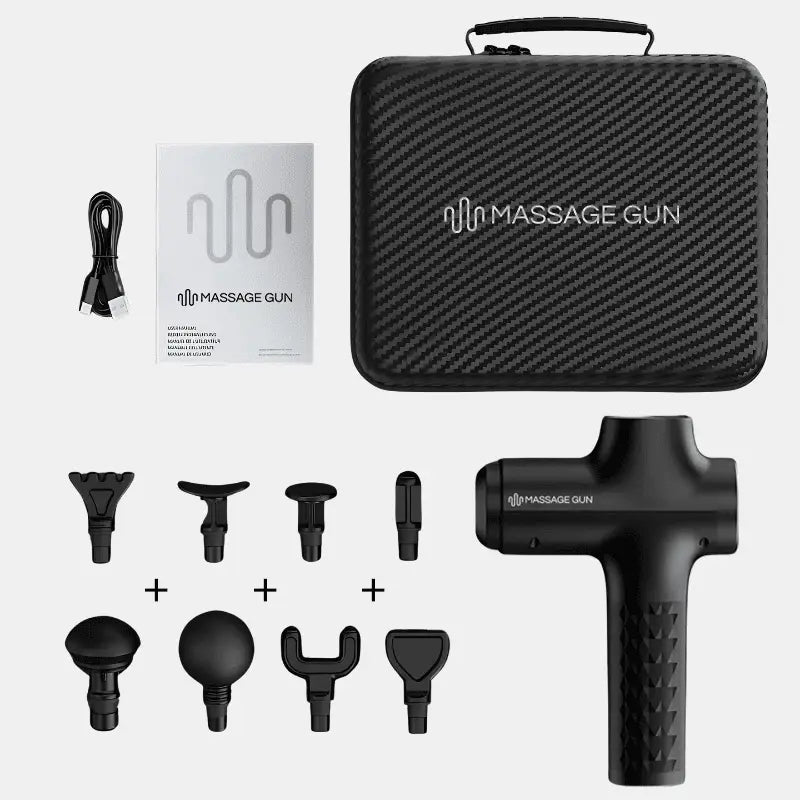Las pistolas de masaje se han vuelto populares para mejorar la recuperación muscular y aliviar el dolor. Estos dispositivos utilizan terapia de percusión para actuar sobre el tejido muscular y reducir el dolor después de una actividad física intensa.
Ya sea que busques mejorar tu rendimiento deportivo o simplemente aliviar la tensión muscular, usar una pistola de masaje en el momento adecuado puede marcar la diferencia. Esta guía te ayudará a entender cómo y cuándo usar una pistola de masaje para obtener resultados óptimos, con el respaldo de evidencia científica y recomendaciones de expertos.
Comprender los conceptos básicos de una pistola de masaje
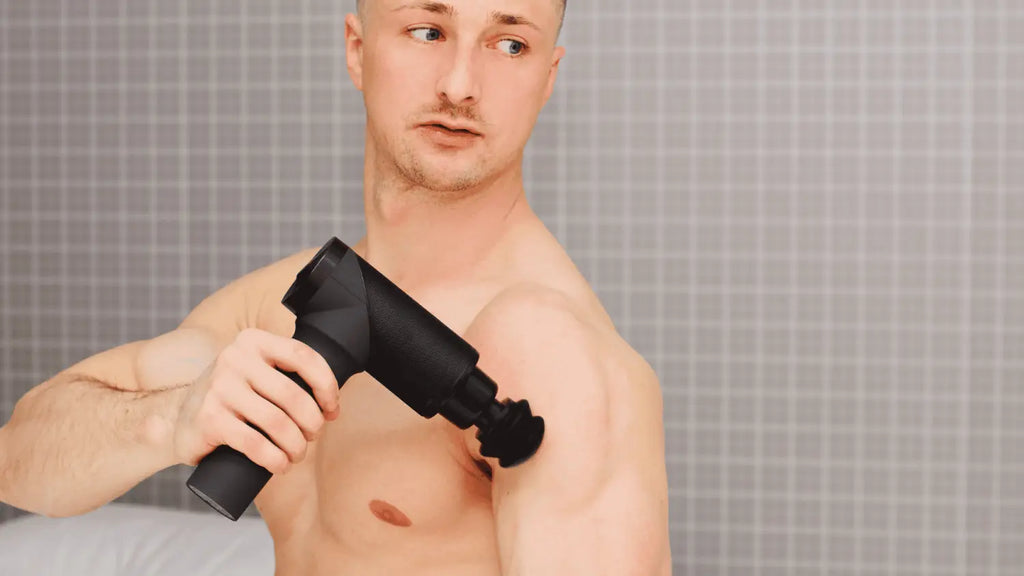
¿Qué es una pistola de masaje?
Una pistola de masaje es un dispositivo portátil que utiliza terapia de vibración para proporcionar un masaje muscular profundo por percusión. El dispositivo aplica una presión rápida al cuerpo , lo que ayuda a relajar los músculos tensos y a mejorar el flujo sanguíneo.
Utilizado frecuentemente en fisioterapia deportiva, ha ganado popularidad entre atletas y aficionados al fitness por su capacidad para mejorar la recuperación y reducir la tensión muscular. Estudios publicados en la Revista Internacional de Medicina Deportiva respaldan los beneficios de las pistolas de masaje para aumentar la circulación sanguínea y promover la recuperación muscular.
¿Cómo funciona una pistola de masaje?
Una pistola de masaje utiliza terapia de percusión para penetrar profundamente en el tejido blando. Esta acción mejora el flujo sanguíneo, reduce la acumulación de ácido láctico y facilita la liberación de nudos miofasciales. Ayuda a disolver el tejido cicatricial y mejora la amplitud de movimiento en los músculos tensos.
Al usar una pistola de masaje regularmente, puede aumentar la fuerza muscular y reducir la fatiga. La vibración estimula el sistema linfático, lo que promueve la eliminación de toxinas y mejora la salud muscular general.
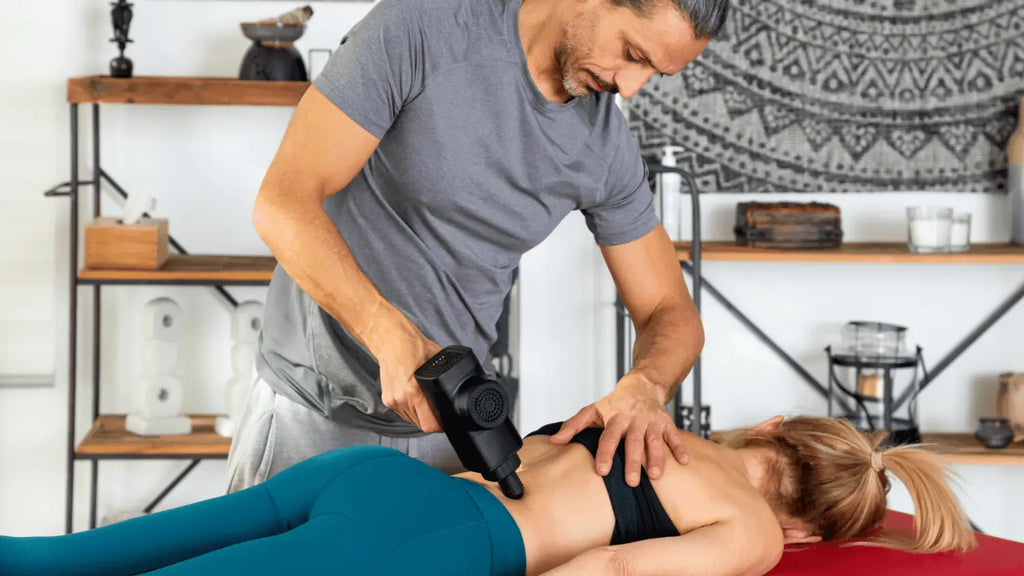
Usos comunes de las pistolas de masaje
Una pistola de masaje se puede usar antes o después del entrenamiento, en días de descanso o cuando necesite aliviar el dolor muscular. Su uso antes del entrenamiento ayuda a calentar los músculos y prepararlos para el ejercicio, aumentando el flujo sanguíneo y la flexibilidad.
Después del entrenamiento, la pistola de masaje ayuda a reducir las agujetas musculares de aparición tardía (DMAT) al acelerar la recuperación y reducir el dolor muscular. Además, estas herramientas son útiles en la rehabilitación y pueden utilizarse para reducir el estrés y mejorar el sueño.
Momentos óptimos para utilizar una pistola de masaje
Pre-entrenamiento: activación de los músculos para el rendimiento
Usar una pistola de masaje antes de entrenar puede mejorar el rendimiento al aumentar la circulación sanguínea y relajar los músculos tensos. Prepara el cuerpo para la actividad física, promoviendo la flexibilidad muscular y reduciendo el riesgo de lesiones.
Las pistolas de masaje son eficaces para la liberación miofascial, lo que permite un movimiento más fluido durante el entrenamiento. Dedica de 3 a 5 minutos a trabajar los principales grupos musculares antes de tu sesión de ejercicio para mejorar el rendimiento.
Post-entrenamiento: acelerando la recuperación
Una pistola de masaje después del entrenamiento es crucial para reducir el dolor muscular y mejorar la recuperación. Tras una actividad física intensa, el dispositivo ayuda a descomponer el ácido láctico, previniendo la acumulación que provoca DOMS. Aplicando una presión moderada en las zonas afectadas, se puede aliviar la tensión muscular y reducir la inflamación.
Este proceso mejora el flujo de nutrientes y oxígeno a los músculos, acelerando la recuperación y reduciendo el dolor muscular. Use la pistola de masaje durante 10 a 15 minutos para tratar los músculos doloridos y reducir la rigidez.
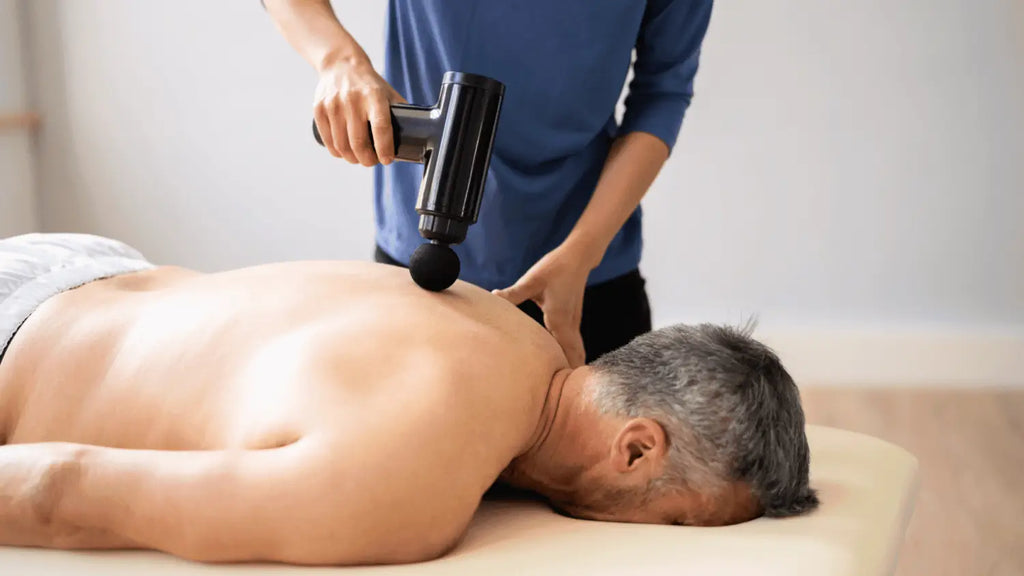
Días de descanso: mejorando la flexibilidad y la movilidad
Usar una pistola de masaje en los días de descanso puede mejorar la amplitud de movimiento y reducir la rigidez muscular. Al mantener los músculos relajados, ayuda a prevenir la rigidez causada por largos periodos de inactividad.
Las pistolas de masaje también ayudan a promover el movimiento del líquido linfático , lo que ayuda a eliminar desechos y reducir la fatiga muscular. Incorporar la terapia de percusión a la rutina de los días de descanso puede mejorar la recuperación muscular general y favorecer la salud muscular.
Escenarios especiales: cuándo utilizar una pistola de masaje
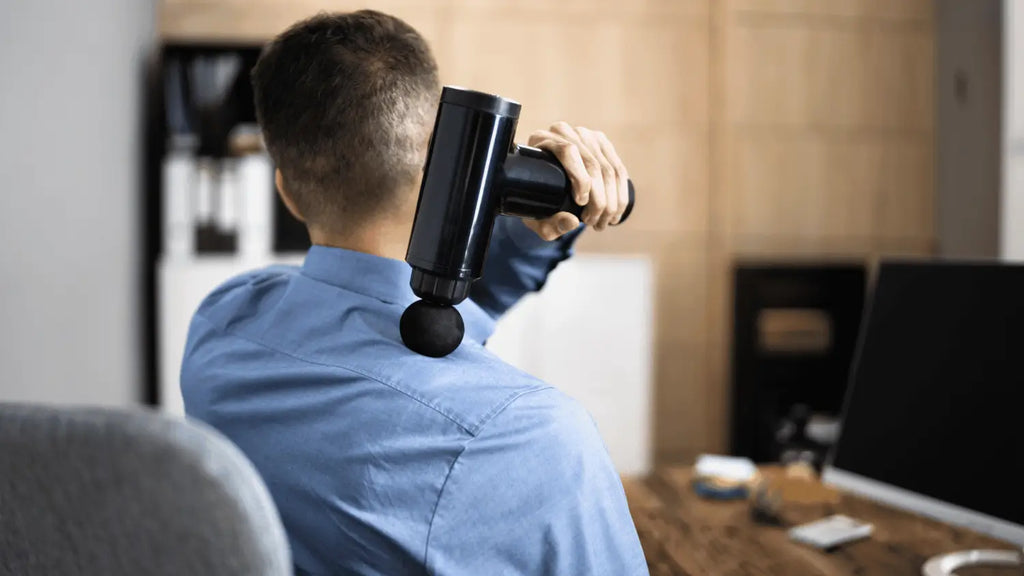
Permanecer sentado durante largos periodos: alivio de la rigidez muscular
Si pasa varias horas sentado en un escritorio, una pistola de masaje puede aliviar la rigidez muscular causada por una mala postura y la inactividad. Permanecer sentado durante mucho tiempo suele provocar rigidez muscular en la espalda, el cuello y las caderas.
Usar una pistola de masaje durante tan solo 5 a 10 minutos en estas zonas puede relajar los músculos, mejorar la circulación y reducir la rigidez. Su uso regular en estas situaciones ayuda a prevenir la tensión muscular a largo plazo.
Durante el viaje: aliviar la tensión muscular inducida por el viaje
Viajar puede dejar los músculos rígidos y doloridos, especialmente después de vuelos largos o viajes en coche. Una pistola de masaje portátil puede aliviar la rigidez muscular causada por el viaje. Ya sea en la zona lumbar o en las piernas, la pistola de masaje ayuda a mejorar el flujo sanguíneo y a liberar la tensión.
Por ejemplo, utilizar la pistola de masaje durante escalas o descansos puede aliviar la rigidez muscular y prevenir lesiones futuras.
Consideraciones para un uso seguro
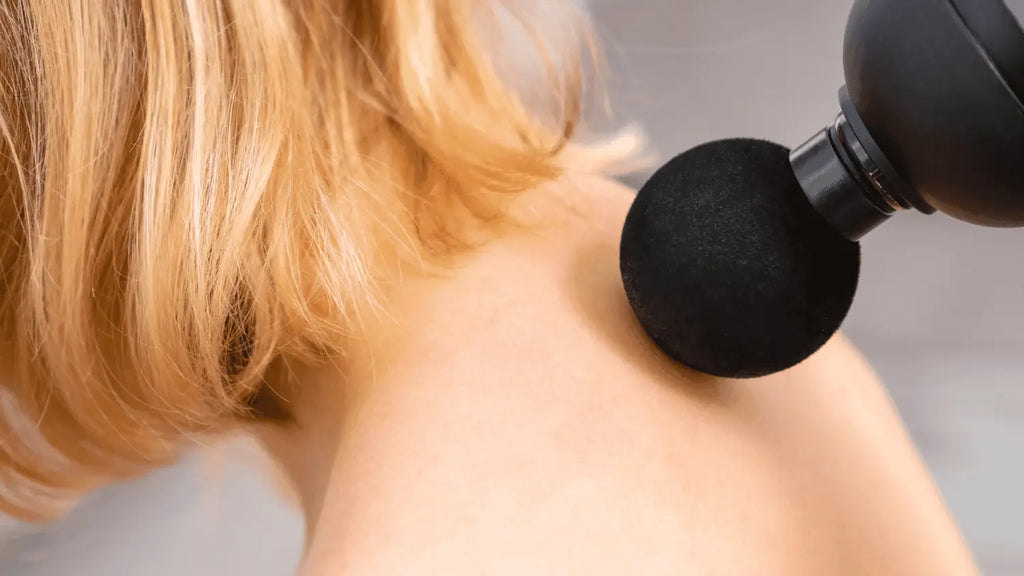
¿Cuándo debes evitar el uso de una pistola de masaje?
Aunque las pistolas de masaje ofrecen muchos beneficios, no son aptas para todos. Evite usarlas en zonas con heridas abiertas, inflamación grave o lesiones. Las personas que toman anticoagulantes o padecen ciertas afecciones médicas, como problemas articulares o fracturas óseas, deben consultar a un médico antes de usar una pistola de masaje .
Aplicar demasiada presión cerca de zonas sensibles, como los huesos, puede provocar más lesiones. Si tiene dudas, consulte siempre con un fisioterapeuta certificado.
¿Con qué frecuencia debes utilizar una pistola de masaje?
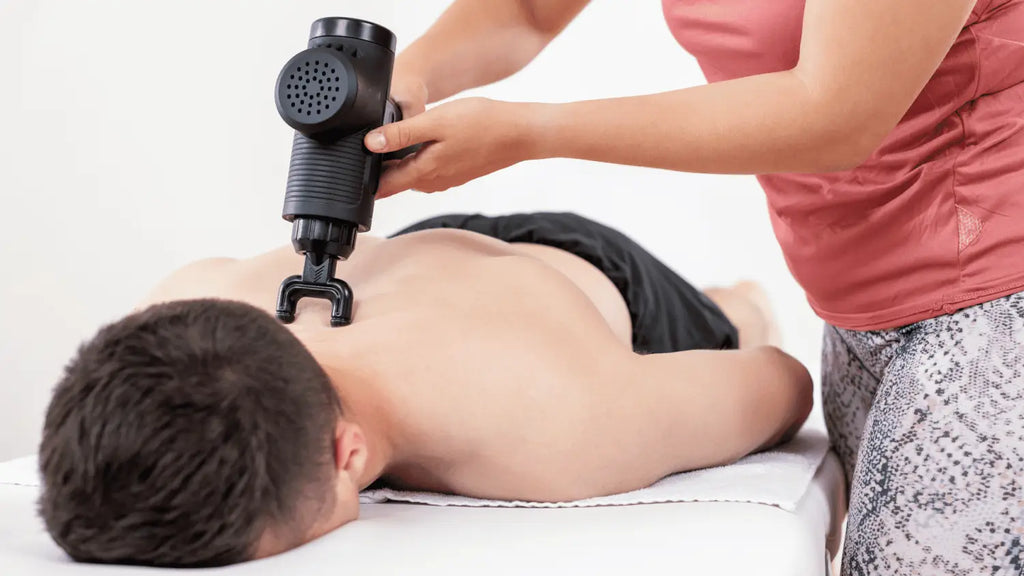
Para la mayoría de las personas, usar una pistola de masaje de 3 a 4 veces por semana es suficiente para promover la recuperación muscular y reducir las agujetas. Cada sesión debe durar de 5 a 10 minutos por grupo muscular.
Evite el uso excesivo del dispositivo, ya que puede causar fatiga muscular o hematomas. Preste atención a las señales de su cuerpo y ajuste la intensidad y la frecuencia de uso según sus necesidades de recuperación.
Beneficios de usar una pistola de masaje regularmente
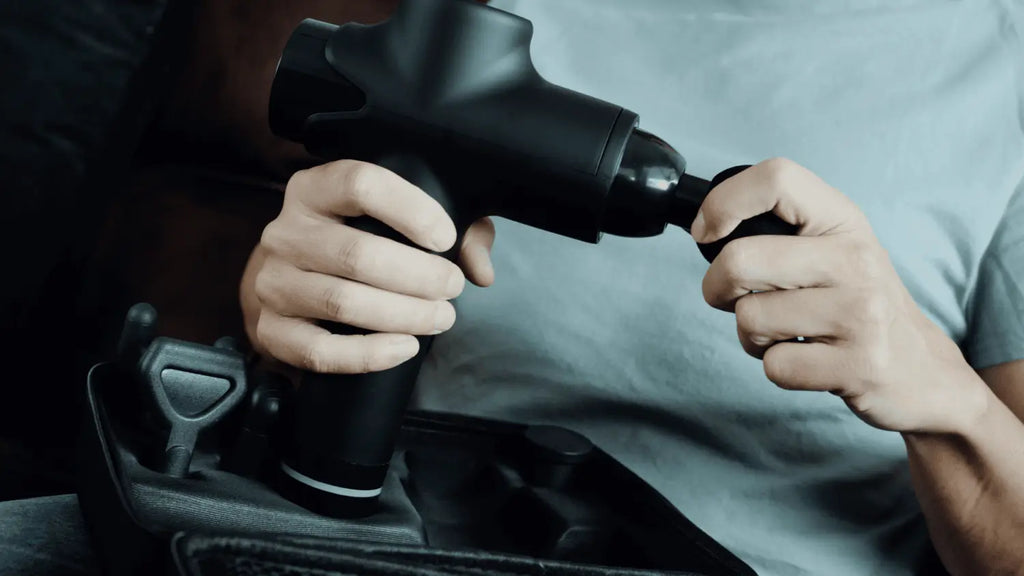
Recuperación muscular y alivio del dolor.
El uso regular de una pistola de masaje puede ayudar significativamente a reducir el dolor muscular y aliviar el dolor. Al mejorar la circulación sanguínea y disolver el ácido láctico, acelera el proceso de curación y ayuda a aliviar el dolor muscular crónico.
El movimiento de percusión promueve la recuperación profunda de los tejidos, lo que lo hace ideal para quienes se recuperan de entrenamientos intensos . Con el uso continuo, notará una mayor fuerza muscular y menos lesiones con el tiempo.
Mayor flexibilidad y rango de movimiento
Usar una pistola de masaje con regularidad puede mejorar la amplitud de movimiento y la flexibilidad general. La terapia de percusión ayuda a relajar los músculos tensos y mejora la movilidad articular.
Esto es especialmente beneficioso para deportistas o personas que realizan actividad física frecuente. A medida que mejora la amplitud de movimiento, disminuye el riesgo de lesiones, lo que facilita mantener un estilo de vida activo.
Comparación de pistolas de masaje con otras herramientas de recuperación
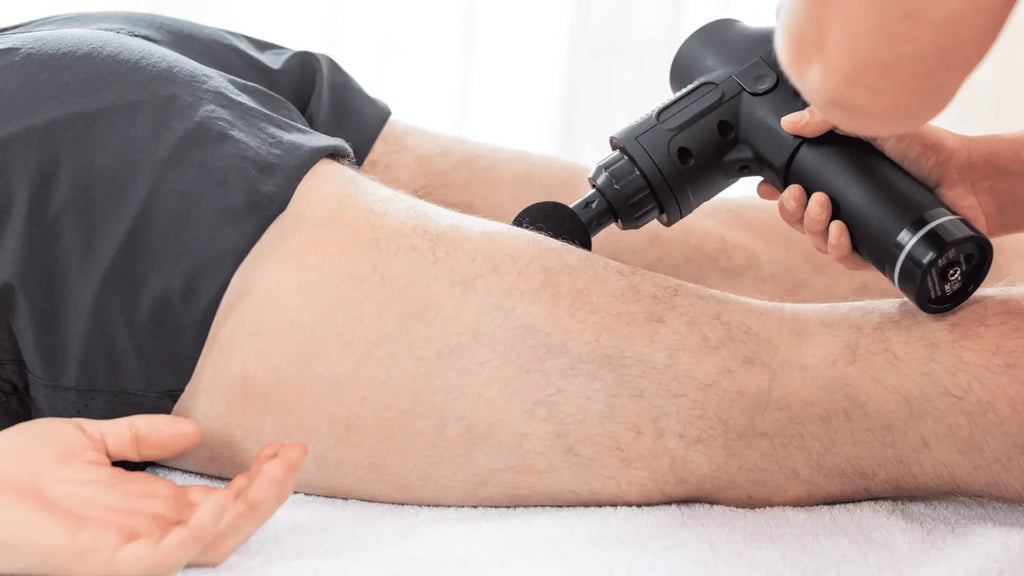
Pistolas de masaje vs rodillos de espuma: ¿cuál es mejor?
Tanto los rodillos de espuma como las pistolas de masaje son eficaces para la recuperación muscular, pero tienen diferentes funciones. Las pistolas de masaje ofrecen tratamientos de percusión más profundos , dirigidos a zonas específicas y proporcionando un alivio más localizado.
Por otro lado, el rodillo de espuma es ideal para cubrir áreas más extensas y promover la circulación sanguínea en todo el músculo. Si necesita concentrarse en una zona tensa o nudos específicos, una pistola de masaje puede ser una mejor opción. Sin embargo, para una liberación general de la fascia, un rodillo de espuma puede ser más efectivo.
Pistolas de masaje vs masaje tradicional: ¿pueden reemplazar a un terapeuta?
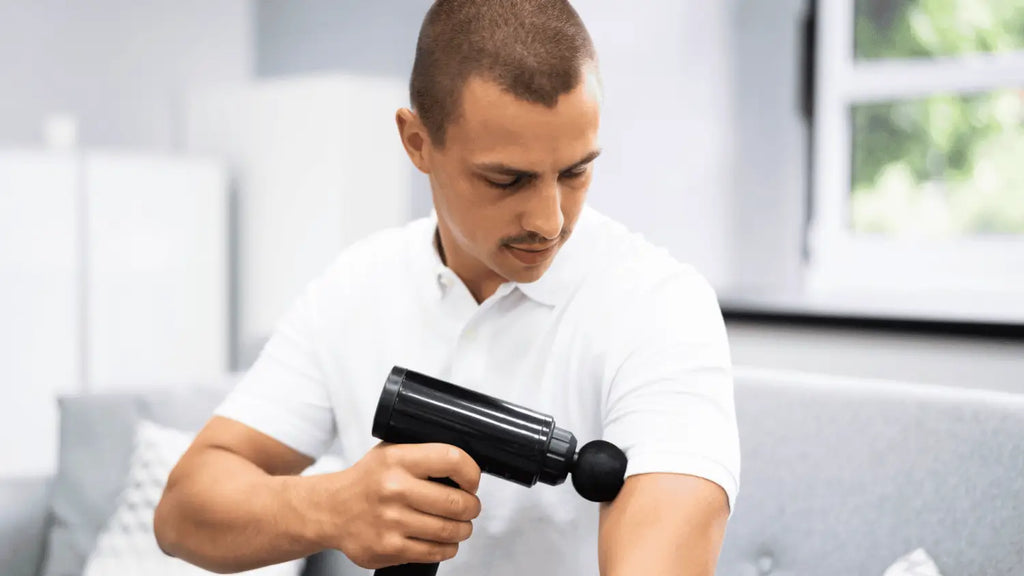
Si bien las pistolas de masaje son excelentes para el uso diario, no deben sustituir la terapia de masaje profesional. Un masajista terapéutico ofrece un tratamiento más personalizado e integral, evaluando sus necesidades específicas y aplicando la presión adecuada.
Las pistolas de masaje son una gran herramienta para el mantenimiento diario, pero aún así se recomienda el cuidado profesional en caso de dolores o lesiones musculares graves.
Preguntas frecuentes
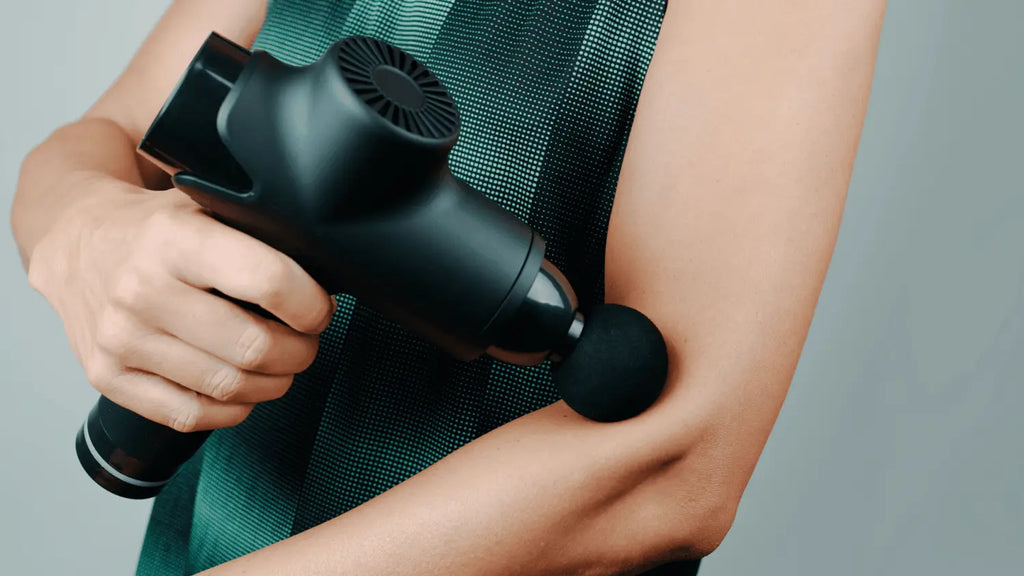
1. ¿Cuándo debo utilizar una pistola de masaje?
Debe usar una pistola de masaje antes o después de la actividad física para reducir el dolor muscular y mejorar la recuperación. Usar una pistola de masaje antes del entrenamiento ayuda a calentar los músculos y a aumentar el flujo sanguíneo, lo que reduce el riesgo de lesiones.
El uso de la pistola de masaje post-entrenamiento favorece la recuperación muscular al descomponer la fascia y mejorar la circulación. El mejor momento para usar una pistola de masaje es durante momentos de tensión muscular , tras largos periodos de inactividad o después de ejercicio intenso.
Recuerde evitar zonas sensibles como la piel sobre los huesos o zonas con lesiones. Para un uso óptimo, comience con una presión ligera y aumente gradualmente según la sensibilidad de sus músculos.
2. ¿Puedo utilizar una pistola de masaje todos los días?
Sí, el uso diario de una pistola de masaje es seguro para la mayoría de las personas, pero es importante moderar su frecuencia. Usar una pistola de masaje a diario puede proporcionar beneficios continuos, como la reducción del dolor crónico, una mejor recuperación muscular y un mayor flujo sanguíneo.
Sin embargo, siempre escucha a tu cuerpo y asegúrate de no excederte, especialmente si sientes dolor después de usarlo repetidamente. La ciencia de la terapia con pistolas de masaje demuestra que su uso regular puede ayudar a reducir el estrés, mejorar el sueño e incluso mejorar la resistencia muscular .
La terapia con pistola de masaje es un gran complemento a las prácticas de medicina alternativa como el masaje de tejido profundo y los tratamientos de tejido conectivo.
3. ¿Debo usar una pistola de masaje antes o después de entrenar?
Puedes usar una pistola de masaje antes y después de entrenar . Su uso preentrenamiento ayuda a calentar los músculos, aumentar el flujo sanguíneo y prevenir lesiones al mejorar la amplitud de movimiento del tejido conectivo.
Después del entrenamiento, la pistola de masaje favorece la recuperación muscular al descomponer el ácido láctico y la fascia, aportando el oxígeno y los nutrientes que los músculos necesitan. El mejor momento para usar una pistola de masaje depende de tus objetivos: úsala antes para activarla y después para acelerar la recuperación.
Múltiples estudios, incluidos los del International Journal of Sports Medicine, han analizado los beneficios de las pistolas de masaje para la recuperación del entrenamiento.
4. ¿Es seguro utilizar una pistola de masaje en músculos doloridos?
Sí, usar una pistola de masaje sobre músculos doloridos es seguro y puede ayudar a aliviar la tensión. Las pistolas de masaje de percusión ayudan a reducir la tensión muscular y a promover la recuperación al aumentar el flujo sanguíneo a la zona afectada.
Si tienes los músculos doloridos después de entrenar, una sesión de masaje con pistola después del entrenamiento te ayudará a aliviar la rigidez y a mejorar la recuperación muscular. Sin embargo, es importante evitar las zonas lesionadas o inflamadas.
Si tiene dudas sobre un dolor muscular específico, consulte siempre con un terapeuta físico certificado o un masajista. Según la evidencia científica, las pistolas de masaje son eficaces para reducir el dolor muscular, especialmente en las zonas doloridas después del entrenamiento.
5. ¿Con qué frecuencia debo utilizar una pistola de masaje?
Puede usar una pistola de masaje de 3 a 4 veces por semana para obtener resultados óptimos , aunque el uso frecuente es seguro para la mayoría de las personas. Cada sesión debe durar entre 5 y 10 minutos por grupo muscular, dependiendo de la intensidad de la actividad.
Los estudios sobre la terapia con pistolas de masaje sugieren que su uso regular mejora los beneficios de la recuperación al reducir la fatiga muscular, mejorar la resistencia y mejorar la circulación sanguínea.
Para evitar lesiones, limite su uso a las zonas de tensión y dolor, y deje que sus músculos descansen y se recuperen. El uso frecuente puede ayudar a fortalecer, reducir el dolor crónico y mantener los músculos sueltos y flexibles.
6. ¿Puedo usar una pistola de masaje si tengo una lesión?
En casos de lesiones menores, como distensiones o tensiones musculares, el uso de una pistola de masaje puede favorecer la recuperación muscular y reducir el dolor . Sin embargo, evite usarla en zonas con fracturas, hematomas o inflamación grave.
La pistola de masaje de percusión está diseñada para aplicar presión localizada, lo que podría agravar ciertos tipos de lesiones. Para personas con afecciones más graves, se recomienda consultar con un fisioterapeuta certificado.
Las pistolas de masaje también pueden ser beneficiosas para la rehabilitación, pero su uso siempre debe ser revisado por un profesional médico.
7. ¿Cuánto tiempo debe durar cada sesión con pistola de masaje?
Cada sesión con pistola de masaje debe durar entre 5 y 10 minutos por grupo muscular para un alivio eficaz de la tensión y la recuperación muscular. La duración exacta depende de sus preferencias personales, el nivel de dolor muscular y la condición muscular.
Las sesiones más largas pueden ser beneficiosas para grupos musculares más grandes, pero sesiones más cortas de terapia de percusión suelen ser suficientes para aumentar el flujo sanguíneo y aflojar los músculos tensos.
Comience siempre con una presión ligera y aumente gradualmente la intensidad. Si utiliza la pistola de masaje para aliviar el dolor crónico o la fascia tensa, podrían ser necesarias sesiones un poco más largas (hasta 15 minutos).
8. ¿Cuáles son los beneficios de utilizar una pistola de masaje con regularidad?
El uso regular de una pistola de masaje ofrece múltiples beneficios, como la reducción del dolor muscular, una mejor recuperación y una mayor amplitud de movimiento . El dispositivo es eficaz para descomponer la fascia y reducir la fatiga muscular tras una actividad física intensa.
Al mejorar el flujo sanguíneo y relajar el tejido conectivo tenso, promueve una mejor salud muscular y previene lesiones. Su uso regular también puede ayudar a reducir el estrés, mejorar el sueño y mejorar la resistencia física general.
Un estudio publicado en el International Journal of Sports Medicine ha confirmado los beneficios de utilizar el masaje de percusión de forma regular.
9. ¿Puedo usar una pistola de masaje para calentar antes de un entrenamiento?
Sí, usar una pistola de masaje antes de entrenar es muy efectivo para calentar los músculos y aumentar el flujo sanguíneo. Ayuda a relajar los músculos tensos, lo que prepara el cuerpo para el esfuerzo físico y reduce el riesgo de lesiones.
El uso pre-entrenamiento también aumenta el rango de movimiento en las articulaciones y el tejido conectivo, lo que aumenta la efectividad del entrenamiento. Para obtener mejores resultados, dedique de 3 a 5 minutos a cada grupo muscular principal que se trabajará durante la actividad.
10. ¿Qué debo evitar al utilizar una pistola de masaje?
Al usar una pistola de masaje, evite aplicarla en zonas sensibles como huesos, articulaciones o heridas abiertas. Tenga cuidado al usarla cerca de vasos sanguíneos o en zonas con antecedentes de lesiones. Es importante comenzar con una presión ligera y aumentarla gradualmente según sea necesario.
Evite usar fuerza excesiva, ya que podría dañar la piel, causar hematomas o provocar lesiones adicionales. Según profesionales certificados, las pistolas de masaje son más adecuadas para las zonas de tejido blando y su uso debe limitarse para reducir la fatiga muscular y prevenir posibles lesiones.


